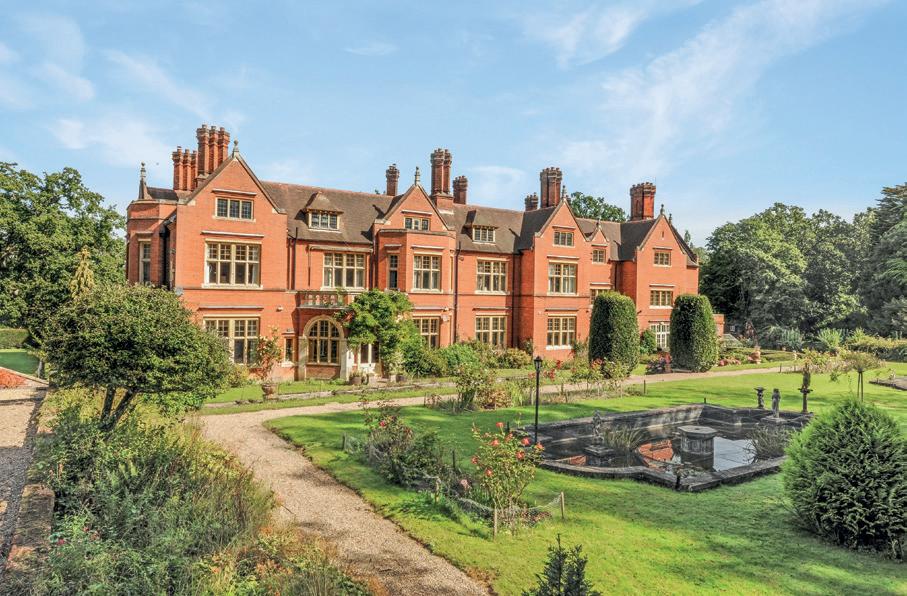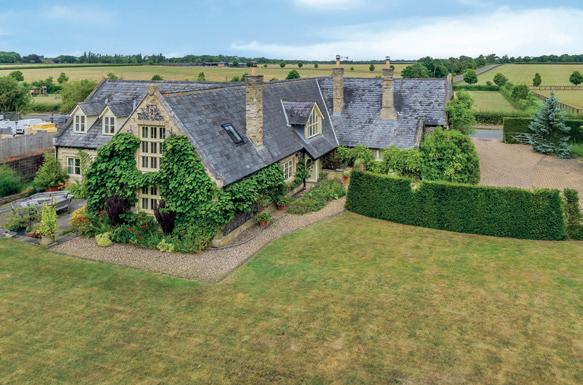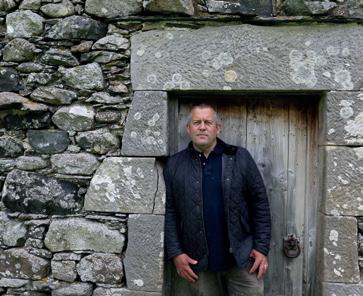www.jackson-stops.co.uk
LONDON COUNTRY

The blooming of domestic and international demand.
Permanent hybrid working driving long-term change.
NEW HOMES
Low energy and low carbon move centre stage.
N O 51
2023

Country Market Comment
64% WORKING FROM HOME
Amidst talk of a ‘return to normality’, a survey for Jackson-Stops suggests that hybrid working has created an engine of long-term change in the country house market.

3
Left: Gloucestershire £6,500,000 guide (Chipping Campden)
Front cover: West Sussex £3,250,000 guide (Mid Sussex)
Good news from our offices across the country: a less frenetic market is encouraging those whose move will involve a chain, to make their move. Seeing that they will no longer immediately be out-paced by competitors with cash, buyers who must also sell (i.e. most of them) are entering the fray once more. Coupled with better interest rate expectations, this is improving supply and generating a feeling of relative normality. Even so, the impact of the pandemic is far from over and, as explained further below, looks far-reaching.
AFTERSHOCKS (SUPPLY CHAINS AND BUILDERS)
Far more buyers than usual are avoiding houses that need a lot of work. Their assumption is that supply issues have made materials excessively expensive and that getting a builder, at any price, will just take too long. With one or two caveats*, these valid concerns should ease. National sales volumes were some 20% above average across 2021 and the first
half of last year, creating a bulge in demand for renovation work. But volumes dipped so much in the second half of 2022 that final figures might show the year to have ended as much as 20% down. Volumes are recovering but in the meantime the dip, just like the bulge, will feed through.
ENERGY, INTEREST RATES AND PRICES: ALL ABOUT MONEY
Energy and finance costs are the two big, nonCovid related factors being felt most keenly. Tim Firth at our Weybridge office says he is seeing more downsizing now, than in 20 years. The prompt is energy cost. Especially
Above: Suffolk £2,750,000 guide (Ipswich)
Below left: Cheshire £3,500,000 guide (Alderley Edge)


Below right: Surrey £3,500,000 guide (Oxted)
 *E.g. 42% fall in EU nationals working in UK construction 2017-2020 (ONS).
*E.g. 42% fall in EU nationals working in UK construction 2017-2020 (ONS).
Right: Devon excess £2,000,000 (Bridport/Dorchester)
Below: Devon, excess £3,500,000 (Exeter)




who can afford that expense, increasingly see it as unacceptably wasteful. Supply is thus improving, particularly for those seller-buyers who need somewhere bigger. Buyers across the board are more price sensitive because of higher mortgage rates, but the general feeling of relief on this front is palpable. Realities and expectations are now much more within manageable norms, than towards the end of last year. There is a measured confidence abroad which feels more balanced. We are thus experiencing no great drama in relation to prices or underlying values and do not anticipate any.
FAMILY REACTIONS: LET’S MAKE UP FOR LOST TIME
Another point made by Tim Firth and echoed by colleagues from Truro to York looks, if not permanent, longer-term at least. It is the desire of families living far apart, to be living closer together and make up for time lost during lockdowns. This includes grandparents
5 UK Market Review | N 0 51; 2023
moving from rural areas, to commuter areas such as Weybridge and Alderley Edge. In more distant commuting zones such as much of Kent and Suffolk, it includes instances of two generations moving somewhere new. Often, they are choosing locations made practical by the advent of widespread hybrid working. Indeed, it is striking that the pandemic appears to have tightened geographical ties to family, whilst loosening those to the workplace.
THE ONE POLL JS HOUSEBUYER SURVEY: HYBRID WORKING IS THE NEW NORMAL
A survey carried out for this firm in February 2023 by One Poll, asked 500 prospective homeowners a variety of questions, including how often they commuted to their place of work. Of those in work, whilst just 5% work fully remotely, 64% work at least one day a week from home. Taking the sample as a whole, over half – 52% – of their paid working days, are worked at home. These findings chime with those of the ONS (44% working from home) and the USbased WFH Institute (which also identifies that, amongst English speaking nations, the UK has the highest proportion of job postings offering hybrid work).
Even should the total of all working days fall substantially (30% is more typical in the US), this still amounts to an astonishing degree of change: the total beforehand is thought to have been less than 5%. Why has this only happened now, given that the technology was there for years? Presumably because, suddenly
The effects of this collective shift are only beginning. Those who share parenting can, between them, always do the morning school run and attend 9am meetings. With less commuting, more time can be given to local events and to family life (including those newlylocal grandparents). Living a little further from the station becomes more practical, as does using local cafés, bars and cinemas. Are we seeing this happening now? The start of it, certainly. For example, Stuart Routledge at our Oxted office says that, in contrast with pre2020, their weekday viewings now exceed those at the weekend. In Sevenoaks, Gaynor Cooper stresses that most buyers still want the advantages of commuter town life. The big difference now, is that they will be able to enjoy them all the more. Hybrid working, she concludes, just takes a bit of the pressure off. For such commuter towns and the more rural communities around them, the shift towards hybrid working, still in its early stages, looks to be permanent and positive.
Above: Cambridgeshire £1,350,000 guide (Newmarket)
Below: Norfolk £2,100,000 guide (Burnham Market)


Opposite page, top: Kent £4,080 pcm (Cranbrook)
Bottom: Northamptonshire £3,750 pcm (Northampton)
UK Market Review | N 0 51; 2023 6
'Over half of their working days, are worked at home.'
SUPPLY IS UP - IF NOT ENOUGH
The private rental sector is bigger than ever, yet still demand outstrips supply. Laudable measures to improve tenant energy costs and security, might not help.
In the decade to 2021, the number of private rental households in England grew by 28%, to almost five million (20% of the housing stock)*. Yet we still have an excess of demand and rents keep rising. Are there any signs that supply might grow to better balance demand? A fewbut yet more new rules, might stifle it.
From 2025, all homes rented under new tenancies must have an Energy Performance Certificate (EPC) efficiency rating of C or above. From 2028, this will apply to all rentals. Most will require expenditure of at least £2,000, often much more, to reach this standard. The fine for not having an EPC is going up too, by £5,000 to £30,000.
Less certain but potentially more serious is Michael Gove’s abolition of ‘no fault evictions’, proposed in his department’s white paper ‘A fairer private rented sector’ (see gov. uk). If passed, this would probably reverse growth in the private rental sector. That
seems unlikely at present: the most vociferous objections to the paper have come from groups representing tenants, such as Shelter. But it does indicate the intended direction of travel.
More positively, we are now seeing the steady if slow return to the long-term market, of thousands of rural rentals which, during lockdown, switched to short-term (less than six months). Extra supply is also coming from landlords - especially those with cash - buying new stock, attracted by higher rents and a less bullish sales market. For landlords who do need to borrow, interest rates are much improved since the autumn and lenders are once again keen to lend, hence finance is much less of a barrier. Greater confidence in the stability of capital values and the potential for mediumterm growth, is helping, too. Will all of this be enough to balance the market? That seems unlikely. We might well, however, have passed the point of greatest extremity.
*English Housing Survey / ONS.


7 Country Rentals
A small selection of some of the eye-catching country houses that we have sold over recent months.




SOLD!
Anglesey
Sussex

Devon

SOLD!
Above: Cornwall £1,450,000 guide (Truro)
Right: Oxfordshire £2,140,000 guide (Burford)
Opposite page, clockwise from the top: Somerset £1,850,000 guide (Taunton)
£1,750,000 guide (Chester)
£1,000,000 guide (Chichester)
£695,000 guide (Barnstaple)

London Market Comment
LONDON BLOOMING
A market that continues to flourish.

11
Left: St George's Drive, SW1V, £10,000,000 (Pimlico)
With strong international demand, iconic landmarks and centuries of history, London continues to be a highly desirable place to live, work and invest. Our own economic landscape may be changing but demand is growing stronger. The number of people looking through us for their next home in the capital has increased by a staggering 49% compared with this time last year. It is little wonder that the market sceptics are being proved wrong. We are completely focused on finding the best buyer or tenant and achieving the very best
price. We know that on average 17 out of every 20 viewings we generate come from our own database and not the internet. A recent example of this was when a detached mansion in the prestigious Burwood Park Estate, Weybridge, with an asking price in excess of £4,000,000 was quickly sold to a buyer after having been on the market for some time with many other agents. Sales Director, John Williams, explains, “It is rare for a buyer to purchase what they first enquire about which is why we pick up the phone and talk to people.

UK Market Review | N 0 51; 2023 12
London Market Comment
Above: The Tower, 1 St. George Wharf, SW8 £2,300,000 guide (Pimlico)
'The number of people looking through us for their next home in the capital has increased by a staggering 49% compared with this time last year.'
Above: Kingston Lane, TW11 £7,000 pcm (Teddington)
Below: Kensington Gardens Square, W2 £36,833 pcm (Holland Park)


It is a people business after all, and it is the relationship we build with our customers and clients that delivers success.”
The experience, local knowledge and service we provide are areas of our business that we are most proud of. Combined with our national presence, we are able to support our customers and clients whether they are looking to upsize, downsize or purchase an investment.
With offices strategically positioned in the most desirable locations including Mayfair, Holland Park and Pimlico in prime central London,
and Teddington, Richmond, Wimbledon and Weybridge in Greater London, we are able to offer a fantastic selection of property across the capital and beyond.
The mortgage market has also been bouncing back, with rates showing signs of settling and the most competitive fees for borrowing being on five year fixed products. This long-term confidence from lenders is encouraging buyers to press on with their plans.
Demand for more rental property across the capital continues to be an issue as London is crying out for more landlords. This is coupled with the fact that there is a noticeable resurgence of international relocators. Our Corporate Services and International Relocation team receive thousands of enquiries every year because of our outstanding reach

13 UK Market Review | N 0 51; 2023
across London, assisting investors, global companies, institutions and embassies.
“This lack of supply is encouraging long term tenancies which is our speciality,” says Lynsey Hearne, Lettings Director. “Our primary aim is to deliver the best result for our client and we work hard to attract great tenants who we make sure are well looked after.”
Our tenants and landlords are supported by our Property Management team, who are never more than 15 minutes away to ensure a rapid response, should an issue arise. With regular changes in legislation, more and more of our landlords are now opting for our fully managed service. Our proactive approach prevents the non-payment of rent, maintains a better relationship with the tenant and helps them to look after the property.
London is a resilient market and a world-class investment, with values in prime areas having
increased beyond expectation. With pent up demand for good quality housing, we expect to see yet another busy year. Confidence in our great city is strong and we look forward to supporting our customers and clients throughout their property journey.

UK Market Review | N 0 51; 2023 14
Above: Cranley Road, Burwood Park £3,350,000 guide (Weybridge)
Opposite page, top: Cheshire £4,750,000 guide (Alderley Edge) Opposite page, bottom: Mies van der Rohe’s 1929 Barcelona Pavilion (photo: Ashley Pomeroy at English Wikipedia)
London Market Comment
FUTURE RETROSPECTIVE
Superficially poles part, the Arts & Crafts and Bauhaus movements had common roots and shared objectives. A hundred years later, their influence remains pervasive.
Scanning images of new houses regarded as ‘modern’, echoes of the Bauhaus School in general and of Mies van der Rohe’s 1929 Barcelona Pavilion in particular, are striking. Amongst traditional house styles, the influence of the Arts & Crafts movement and its Edwardian successors, is similarly clear. Does this represent a failure of contemporary architects to ‘move on’? Arguably not: amongst architectural responses to the challenges of industrial scale house building, these principles have endured because they are valued.
With the first railway networks came suburbs and volume house building. New approaches were needed and, in combining practical proportions with homely aesthetics, the Arts & Crafts Movement created a style based around strong rooflines and the use of bricks with clay tiles, which appeals to this day.
Like the Arts & Crafts standard-bearer William Morris, Bauhaus founder Walter Gropius felt there was “an arrogant barrier” between the craftsman and the artist. Removing that barrier
would help to make good design available to the masses. Gropius though, held that Arts & Crafts design was too backward-looking, too Gothic. The future lay in using the structural qualities of steel, glass and concrete, to start anew. That attitude is embodied in the Barcelona Pavilion.

Unfortunately, interpreters of van der Rohe’s design too often failed to see that its simplicity served to highlight its high quality materials. An “affordable” pavilion could highlight only inadequacies. Worse, all that glass, flat roofing and hard floors were fine for Barcelona, but not cold, rainy northern Europe, where most of the houses were being built. Even as Modernism flourished in post-WWII commercial property construction, so it fell from domestic favour.
Today, super-insulating glass, underfloor heating and improved building techniques have created a Bauhaus-inspired revival, especially in high end homes where top quality materials are viable. Our taste for Arts & Crafts inspired homes, never went away. Bauhaus is back for the simple reason that now, it works.

15
Notes on Architecture


New Homes & Developments

ENERGY CENTRE STAGE
Once merely ‘nice to have’, technologies such as renewable energy sources, heat recovery systems and A-grade insulation, are increasingly regarded as essential. In time, self-healing, biologically grown bricks might be, too.

17
Devon £1,050,000 guide (Exeter)
Left:
Louisa Hooper, who heads up New Homes at our Exeter office, has been selling the ultra energy efficient properties of one developer - Heritage Homes - for almost a decade. Throughout that time, all of their houses have been zero carbon, or A-rated for energy efficiency or both. She says that at the beginning the systems involved were, to most buyers, a novelty, perhaps even worryingly unfamiliar. That began to change significantly some five years ago, growing steadily in importance until this year when, as she put it, energy moved centre stage: “What is so striking is how knowledgeable buyers now are, about the different low carbon technologies. It feels that, at last, these brilliant features are being given the credit they have always deserved.”
Louisa’s stock at the moment includes three houses near Exeter which, as one buyer enthused, are “all but off-grid” having a private water supply, solar panels, air source heat pumps and incredibly good insulation,
including triple glazing. She adds that, as well as the low energy costs, buyers are attracted by the minimal maintenance needs of high quality new homes: “My colleagues love their rambling period homes but they can involve a lot of work, year after year, to keep in good condition”.
TAX BREAK DRAWS FIRST TIME BUYERS
The priority of energy efficiency is common across the country, not least in the South East, where the combination of heating costs, high rents and lower stamp duty, is encouraging former tenants to buy, contributing towards a broader strong start to the year. Since September, first time buyers pay no stamp duty up to £425,000 and then 5% up to £625,000. First time buyers at that higher level are still rare, but they do exist, often being older, quite senior executives returning from a long stint abroad. Whatever their position, they do, as Stuart Routledge of our Oxted office has
Above: Cheshire £895,000 guide (Alderley Edge)

Below: West Sussex £2,000,000 guide (Tunbridge Wells)

UK Market Review | N 0 51; 2023 18
seen, strongly resist going over the threshold because, at that point, all tax relief is lost: “Go £1 over £625,000, and the tax payable jumps from £10,000 to nearly £19,000”.
GROWING, SELF-HEALING BRICKS
The majority of new homes are built using materials and methods little different from fifty, even a hundred years ago. This is changing fast, as demand for low energy costs combines forces with new regulations. The Future Homes Standard complements existing building regulations, requiring new homes built from 2025 to produce 75% less carbon emissions than homes built under the old regulations. This has created a stepchange in demand for well-established biomaterials such as cross-laminated timber and ‘hempcrete’ building blocks. The latter are made from hemp and lime and are carbon negative. It is also heightening interest in innovative products such as those of the US company Biomason, which is growing selfhealing biocement. This uses natural bacterial calcification to grow a brick in the same time as it takes to make a kiln fired brick, and to seal cracks and bond surfaces. Whichever materials are most favoured, we look set to see more change on this front in the next ten years, than in the last 100.

KEEN TO LEND
Despite recent turmoil on the international banking scene, UK lenders appeared to have focused on the March budget, reducing swap rates in response. This has increased confidence in the stability of current interest rates with the result that lenders are once again chasing market share. This is true across the board, though the stress tests for some loans are stricter than others.
BTL: HIGHER FEE, LOWER RATE
For buy-to-let mortgages, lenders must look at the ability of rental income to cover the loan cost at the agreed rate, plus a buffer in case rates move. They also have required profit levels. Thus, if a loan needs to be at a lower rate to pass the stress test, some lenders will increase the arrangement fee to offset the reduced profit on the loan. A 5% loan with a 1% fee, might be reduced to 4.5% with a 3% fee or a 4% loan with a 5% fee if needing to stretch borrowing to the maximum.
FEES & LOWEST RATES
The differences between packages offered to borrowers with different levels of risk are currently reflected more in the fees than the rates. Again, this reflects stress tests which determine that, even at high loan-to-value rates, those who receive offers, will be a safe bet. Thus a first time buyer with 10% deposit, buying at the zero stamp duty threshold of £425,000, can often currently secure two year fixed at around 5% or five years at around 4.5%. The most low risk borrowers looking for a fixed rate might be looking at around a 4.4% rate fixed for two years or, for five years, around 3.99%.
For independent advice, contact Private Finance on 0870 600 1650 or jackson-stops@privatefinance.co.uk.
UK Market Review | N 0 51; 2023
Private Finance
www.privatefinance.co.uk
Above: Suffolk £720,000 guide (Ipswich)
TRULY HOME James Rebanks
James Rebanks is a Lake District farmer, working land that has supported his family for six hundred years. His No.1 bestselling debut, The Shepherd's Life, won the Lake District Book of the Year and has been translated into sixteen languages. His second book, English Pastoral, was a Top Ten bestseller, the Sunday Times Nature Book of the Year, heralded as a 'masterpiece' by the New Statesman and longlisted for the Orwell Prize for Political Writing.

PROPERTY EXPERTS SINCE 1910

My whole life I have believed in one idea of what ‘home’ meant. I am from a very deep-rooted family of Lake District farmers. My grandad loved his farm. He was completely, madly, deeply, soppily, in love with it, and rarely left. On rare summer evenings when he and my grandma had time for a rest, they’d walk above their fields, look across the valley, leaning on a gate, and just glow with satisfaction that this was their place. Dad laughed at them, but when he became the farmer, he was as bad. Matterdale really is beautiful – with its white farmhouses, stone barns, hillsides carved into fields by hedgerows and dry-stone-walls, and the fells layering back in the distance. The landscape around us is entirely hand-crafted, and it was literally my ancestors that did the work. It feels deeply personal, truly ‘ours’, truly ‘home’, even if, in truth, we share it with millions of other people each summer. For the past decade I’ve allegedly been the boss on the farm. Helen lets me think so. I’ve written two deeply ‘romantic’ (in the radical sense) books about this place and what we do.
I’ve had the ‘home-is-here’ virus as bad as any of my ancestors. But, lately, I’ve begun to feel a little differently about it, partly because of a book I read, called Where I Was From, by the late Joan Didion. Her book is very different from mine, but it sure made me think. She felt alienated from her childhood home and realised after a while that her ‘home’ was, simply, wherever her husband and loved ones were. ‘Home’ for Joan, was portable, it was the people you loved. I wouldn’t have gone for this idea when I was young, but I am changing. I have four kids, and I realise more and more how much I love my wife. One morning a few months ago, I came back in from the farm and I said to Helen, ‘You know I love this old farm so much, but if we had to leave it for some reason, and we all left together, and were all healthy, then I’d do it no problem… You are my home’. And she looked at me, smiling, and said ‘You idiot, I’ve always felt that way about you’. I guess that realising where your home is, is something that’s better worked out late, than never.
Home jackson-stops.co.uk | Edited and produced by RealBranding.Agency SALES | LETTINGS | NEW HOMES West Country Barnstaple 01271 325153 Blandford 01258 423002 Bridport/Dorchester 01308 423133 Exeter 01392 214222 Shaftesbury 01747 850858 Sherborne 01935 810141 Taunton 01823 325144 Truro 01872 261160 Yorkshire York 01904 625033 Harrogate 01904 625033 Thirsk 01904 625033 London Holland Park 020 7727 5222 Mayfair 020 7664 6644 Pimlico 020 7828 4050 Richmond 020 8940 0066 Teddington 020 8943 9777 Weybridge 01932 821160 Wimbledon 020 8879 0099 Central Northampton 01604 632991 Woburn 01525 290641 Country Houses 020 7664 6646 New Homes 020 7664 6649 South East Canterbury 01227 781600 Chichester 01243 786316 Arundel 01903 885886 Emsworth 01243 370300 Cranbrook 01580 720000 Dorking 01306 887560 Midhurst 01730 812357 Mid Sussex 01444 484400 Oxted 01883 712375 Reigate 01737 222027 Sevenoaks 01732 740600 Tunbridge Wells 01892 521700 Woking 01483 322135 East Anglia Burnham Market 01328 801333 Bury St Edmunds 01284 700535 Chelmsford 01245 806101 Ipswich 01473 218218 Newmarket 01638 662231 Norwich 01603 612333 North West & North Wales Alderley Edge 01625 540340 Lancashire 01704 651029 Chester 01244 328361 Hale 0161 9288 881 Cotswolds, Hereford & Worcs Burford 01993 822661 Chipping Campden 01386 840224
Photo: ©Andrew Heading





 *E.g. 42% fall in EU nationals working in UK construction 2017-2020 (ONS).
*E.g. 42% fall in EU nationals working in UK construction 2017-2020 (ONS).
































